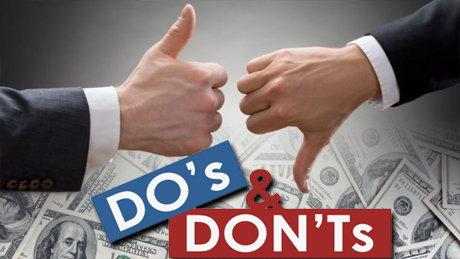The distinction between the sports bettors who lose and those who are able to sustain and expand their bankroll is a value-first attitude.
Most bettors simply try to pick up bets that they think can foresee and disregard the costs of the game. At its worst, this way of thinking places you in an unduly insecure position. You’re probably wildly overpaying for something at best.
The bottom line is, you can’t disregard any amount when you’re trying to make a good bet. In this post, I’m going to set out the do’s and don’ts when it comes to value betting.
1. Don’t: Take Huge Money line Favorites
Of all the low-value bets available, the favorite line of money must be the most common bet on any basis. It makes sense to why. It feels like the most “safe thing” in a world where “safe things” are hard to get through.
Unfortunately, the moneyline favorite bet is possibly also the most dangerous when you consider possible financial consequences.
“Moneyline’s favorites are predicted to win. The thing is, if you’re regularly risking between 150 percent and 200 percent of the money you’re going to receive, the losses (though less in number) will inevitably begin to outweigh the wins in the money column.”
In an ideal world, you’d never have to lose anything than you can earn. In-person or online sportsbooks would not allow this to be the case much of the time, so the next best thing you can hope for is a bet where the risk-return is as near as possible.
Irrespective of how confident you are that your bet is going to strike, if the cost is too high, then the value is just not there to make it worth the risk.
2. Do: Keep Track of Your Plays
You may think that you make a good decision on a regular basis to make a high-value bet, but is that really the case? The only way to know for sure is if you have a monitoring system in place that is checked periodically.
Some bettors get carried away with putting together a tracking sheet and end up making things too difficult to keep going. It’s almost as bad as not getting one.
The trick to a good tracking sheet is to make it as easy as possible without losing essential information. It’s easier said than done, but it’s still manageable.
Below, you’ll find exactly what I’m going to include on my betting sheet. Each group has a column when I make a bet.
“The Matchup Itself”
It’s pretty easy, but you want to know what you’re betting on. Write down who’s going to play. You could end up recognizing a trend where you win at a higher rate when you bet on a certain team.
“The Bet and the Odds”
Here’s where the value begins to come into play. Write down exactly what you see for this column on your bet slip. You may have GB Packers, for example (-5.5 at -110).
“Risk to Win”
This one lets you keep a closer eye on your money and is probably the best predictor of worth. Put a column about how much you lose and how much you can win. I typically make it easy (to save space) and it will look like “100:90” on my sheet (keeping with the -110 bet above).
If you do this regularly, there will be occasions when you find the figures don’t look too favorable. It’s this part of the sheet that can avoid any unwanted play.
“Final Result”
All the above information is what you were expected to write before the game, or just before/after you submit a play. The last part, and the most meaningful one, can be filled in after the game.
Remember that once you’ve won or lost with a +$90 or-$90. The final move is to change your total bankroll figure. Usually, I change the total number when each bet comes to an end, but feel free to add the number at the end of the day, or even the week, if you don’t bet as much.
3. Do: Take a Few Moneyline Underdogs
If the first thing in the “don’t” category is to take the moneyline favourites, it’d be justification to say that doing the opposite is a smart idea, and it is!
“The hard part about betting on moneyline underdogs is simply the cognitive dissonance that occurs when you know that you’re betting your own money on a very unlikely occurrence. The main thing to note is that you’re not trying to win as many bets as you can, but to win as much money as you can.”
While most bettors can’t help but worry about the W’s and L’s on the bet slip, this number isn’t as important as the effect on your bankroll.
I’m not actually saying that any of your plays are moneyline underdogs, but if you’re never playing the game, you’re missing a chance to capitalize where the value is large.
As a side note, this is the kind of bet where some extra research can really pay off. The usually uninformed public will distort the lines, so know how to take advantage of it by heading in the opposite direction.
4. Don’t: Fall Victim to Low Value Prop Bets
I understand there’s a justification for sportsbooks—to make money. With that being said, I still can’t help but feel a little disappointed as I scroll through a list of prop bets only to realize that no matter which choice I select, I’m looking at a-120 rows.
Prop Bets are not all bad.
“While they’re never meant to be a big part of your overall betting strategy, it’s likely that props can be part of a good game plan. However, it is important to be highly selective when determining which ones to take.”
First, at every moment the two sides of the bet are more than-110, I would suggest putting off entirely. On the other hand, if you find prop bets that can get you into a plus-money scenario, that’s something you need to remember.
Bear in mind that in most prop bets, sportsbooks really hit the public’s propensity toward recency bias. For eg, if Damien Lillard has 45 points in the game, the book is likely to set the over/under prop bet higher than it should be. If there’s ever been a time for the public to fade, it’s on the prop bet.
5. Don’t: Only Look at One Sportsbook
This is sports gambling 101, but most bettors disregard the advice: don’t become too loyal to one sports betting site.
In today’s increasingly relaxed world of gaming law, betting players have access to more options than ever before. Unfortunately, a high percentage of these bettors do not take advantage of the opportunities provided by the amount of choices they have made.
The difference in odds does not seem important. In fact, it is noticeable if one sportsbook varies from another by more than one point on the spread or by more than +/-10 at the end of the moneyline. But if you make hundreds of bets a year, these little variations will add up.
Simply put, you’re going to shop around for the best deal on most items, why wouldn’t you do that for betting lines as well?
Conclusion
Value should always be the main focus when making a bet, investment, or even a regular purchase in your daily life. Unfortunately, most sports bettors tend to focus on winning the bet more than winning money in the long-run.
Taking on more risk and betting with value in mind isn’t easy, but if you have the stomach for it, the results can be eye-opening.

